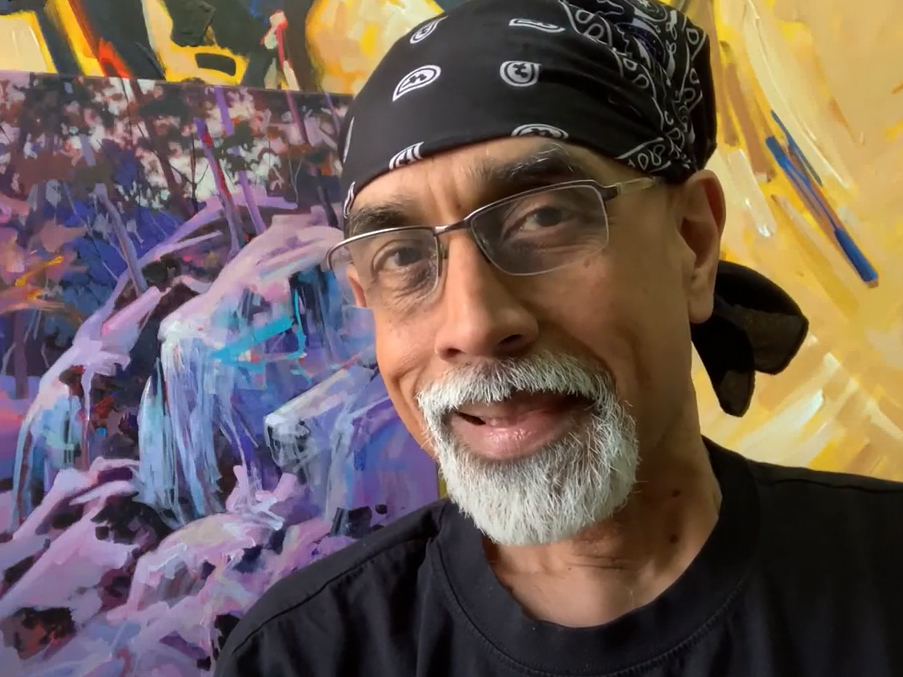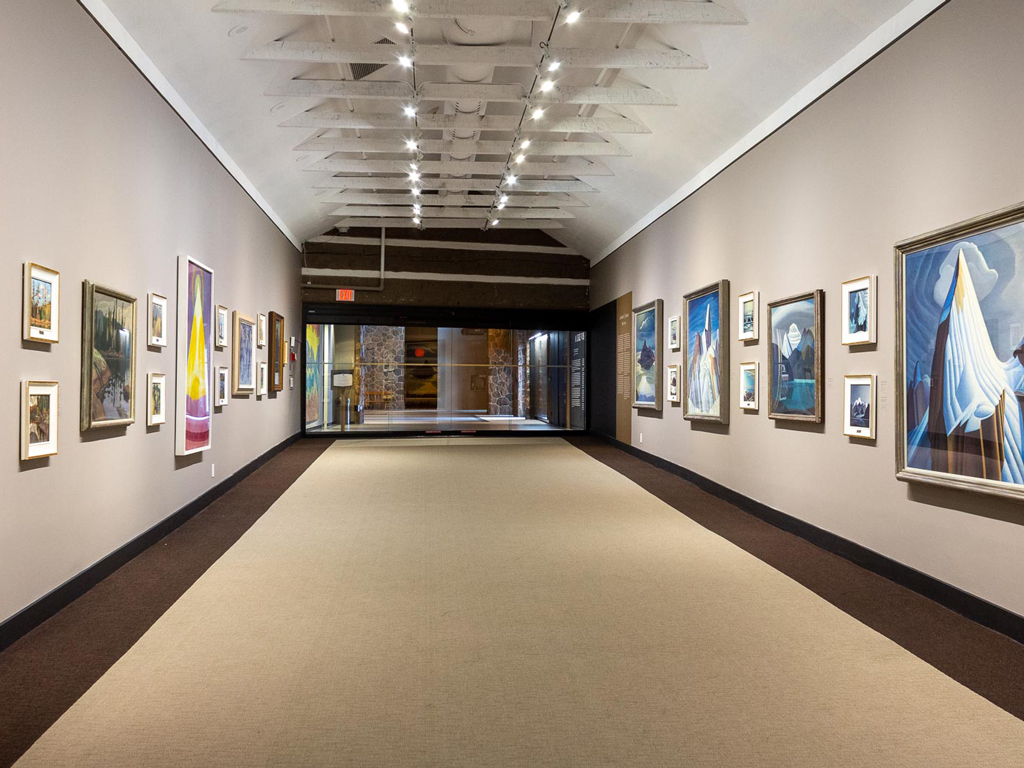ArtVenture Online
There are lots of ways to stay connected with the McMichael collection, educators and artists through art activities, videos, tutorials and more from home! Check back regularly for new posts.
This project video, inspired by artist Christi Belcourt’s floral paintings, will teach aspiring artists of all ages and abilities to create an unforgettable gift for a loved one this Valentine’s Day.
This Halloween, look up and experience the stars, moon and magic of the night sky in a whole new way! In 2020, we have the rare opportunity to enjoy this spooky season under a blue moon, the second full moon in less than one month.
Contemporary Canadian artist Steve Driscoll was inspired by the northern lights to create his large-scale painting Like a daydream, or a fever (2016).
Using pigmented urethane to create his landscapes, the artist created an effect that is almost magical when the urethane dries into clear layers. Follow Driscoll’s lead and use this rare lunar phenomenon as your inspiration to create a little magic of your own!
Today, we are going to create a painting depicting the Halloween night sky.

Steve Driscoll (b. 1980), Like a daydream, or a fever, 2016, Urethane and oil pigment on plastic panel, 214 × 280 cm, Gift of the artist, McMichael Canadian Art Collection, 2017.4
Exploration Questions:
- How is the element of space used in the painting? Do you see more of the sky or the land?
- What is different about the night sky in this painting? Have you ever seen the northern lights?
- How did the artist recreate the feeling of the northern lights swirling and moving up the canvas?
Activity description:
Layer oil pastels (or wax crayons) and watercolour paint to create a magical nocturnal landscape painting. Use your view of the evening sky or your imagination to create a moonlit masterpiece that captures the essence of Halloween night.
Sometimes art can be magical. Some materials, like oil and water, can even work together in a way that seems otherworldly. In this activity, we will explore what happens when we experiment with materials that don’t really get along.
Before we begin, envision the time of day that you would like to paint and reflect on the colours, objects and texture that you’d like to include in your landscape. Steve Driscoll paints his picture from a “worm’s-eye view” while looking up towards a big sky. Choose a viewpoint that you prefer, then begin sketching a landscape using a wax or oil-based material. Both wax and oil will resist your watercolour, so be sure to leave some areas of your surface uncovered. Start with the lightest colours and then build the darker colours on top. Experiment with layers of thin watercolour paint on top of your wax/oil and watch the magic happen!
There are several notable artworks in the McMichael’s permanent collection that showcase the fascination many great artists have had with the starry night sky and nocturnal landscapes.
From Tom Thomson’s evening vistas of Algonquin Park, to Frederick Varley’s paintings of the Vancouver skyline at night, the Group of Seven and their contemporaries frequently explored the effects of moonlight on colours and shadows. Inuit artists often depicted the evening sky through a spiritual lens, populating the darkness with the spirits from the folklore of their culture.

Tom Thomson (1877–1917), Moonlight and Birches, 1915, oil on wood panel, 22 x 26.9 cm, Gift of Mrs. H.P. de Pencier, McMichael Canadian Art Collection, 1966.2.5
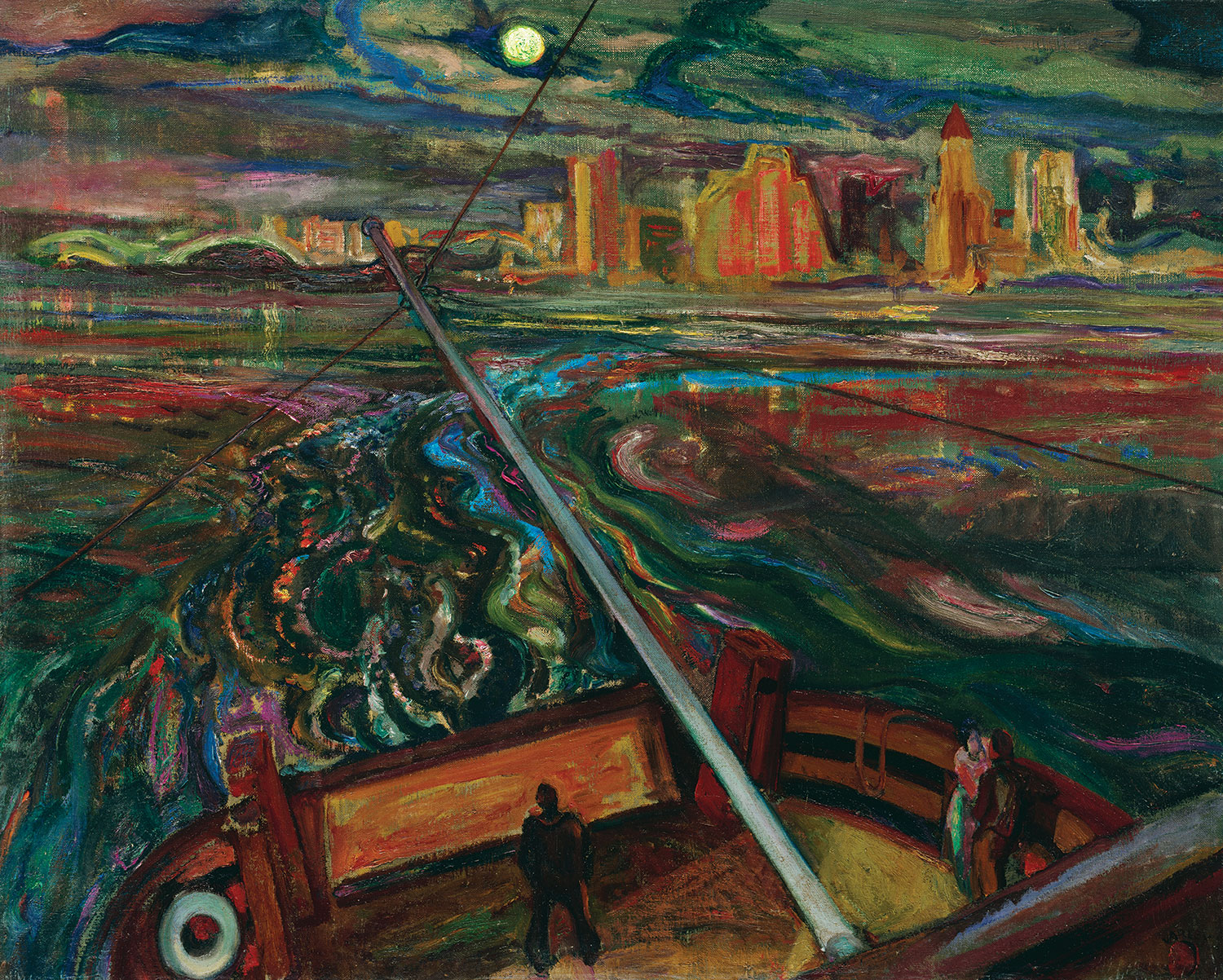
F.H. Varley, Night Ferry, Vancouver, 1937, oil on canvas, 81.9 x 102.2 cm, Purchase 1983, McMichael Canadian Art Collection, 1983.10
Activity description:
Watch this tutorial or download the step-by-step instructions:
 Once in a Blue Moon
Once in a Blue Moon
This year, Halloween night will take on a particularly festive atmosphere with the appearance of a Blue Moon, the second full moon in the period of a month. This unique phenomenon, combined with the beautiful colours of fleeting autumn, will serve as the perfect backdrop to an inspired evening of stargazing.
In these workshops, we invite young artists to challenge themselves to create a nocturnal scene focusing on the features of a landscape at night. Participants are encouraged to draw inspiration from the spooky spirit of Halloween by including creatures they feel may be lurking close by in the shadows…
Kid’s Corner
5 – 7 years old
Visit this page every week for fun step-by-step art activities and ideas for the whole family! Each post will contain an activity connected to one of the McMichael’s artworks, accompanied by guided viewing questions. A list of materials and potential substitutes is provided.
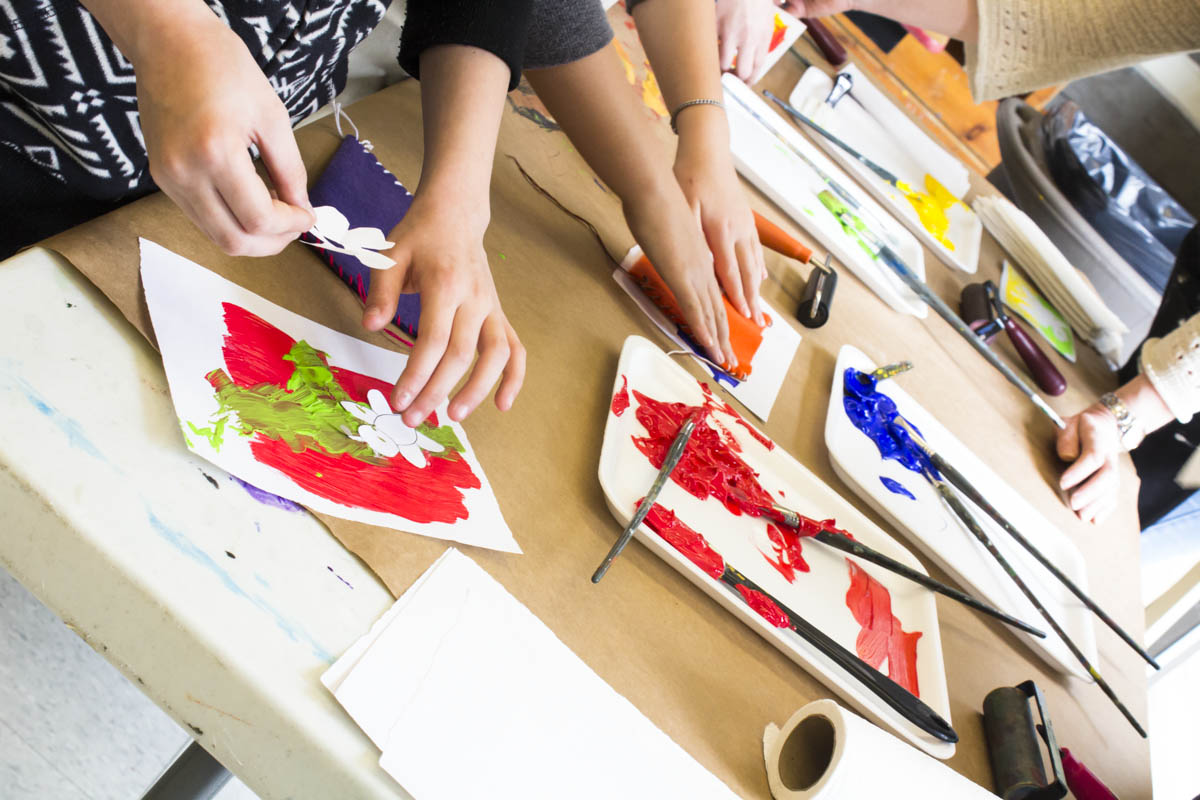
The Canadian landscape can be painted in many different ways. Some artists paint a panoramic view while others, like Group of Seven member Arthur Lismer, chose to focus on the forest floor as the subject of his artwork Canadian Jungle. This unique perspective highlights many different textures in nature. Consider planning an exploration of your home and backyard to discover new textures to serve as a subject of an artwork.
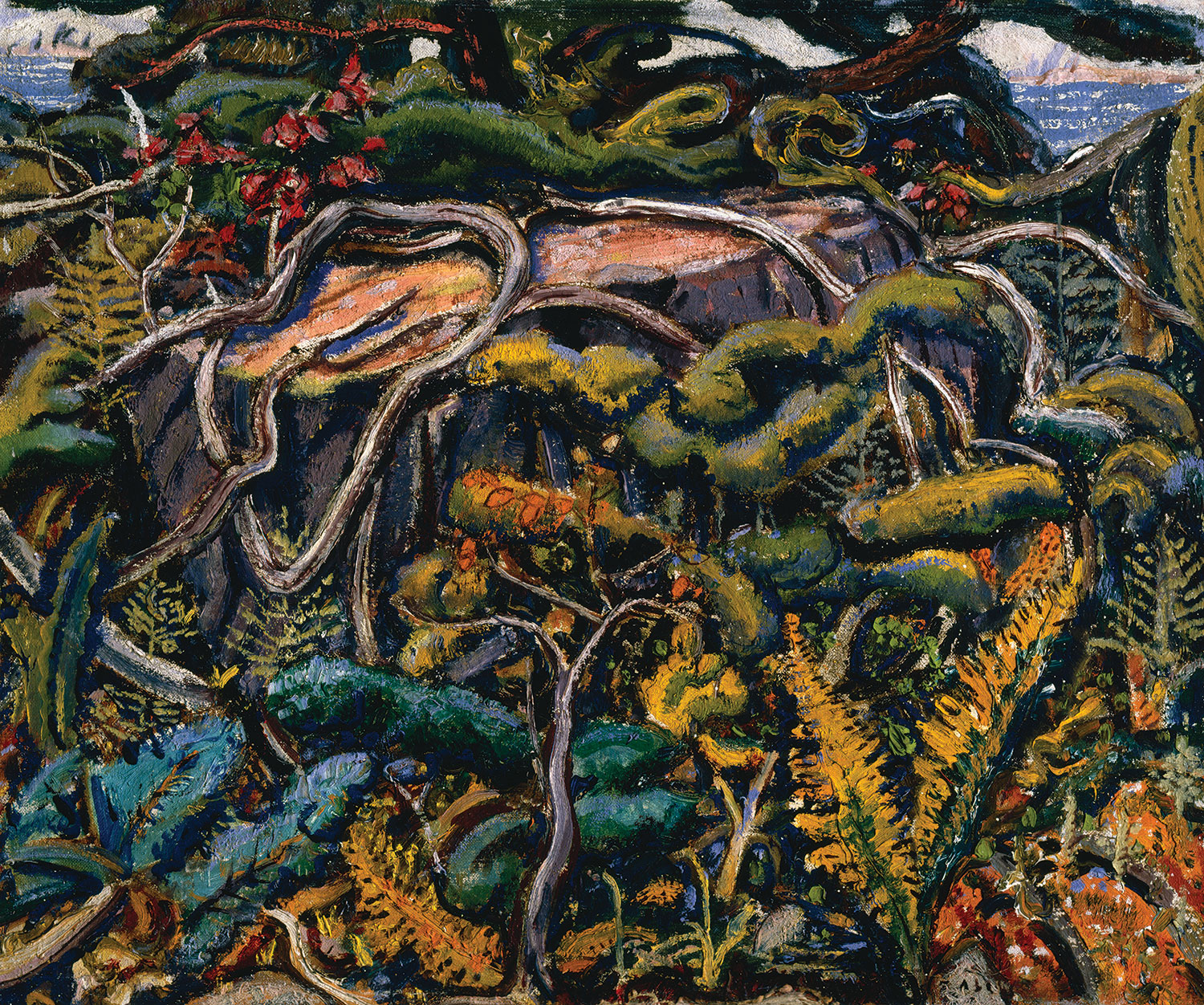
Arthur Lismer (1885–1969), Canadian Jungle, 1946, 44.8 x 53.7 cm, Gift of the Founders, Robert and Signe McMichael, McMichael Canadian Art Collection
Exploration Questions:
- How many natural materials can you spot in this painting?
- Do any of these materials have different textures?
- How many colours has Arthur Lismer used in this artwork?
Activity description:
Use wax crayons to create a texture drawing by laying paper over natural objects found around your home. Use your imagination to be creative and pick various items in your environment to create interesting textures, including leaves, pine needles, pebbles or loose change. Experiment by adding watercolour paint over top of your rubbings and see what happens!
Tom Thomson loved to explore the outdoors and record his discoveries. He would paint and sketch everything he saw: flowers, trees and even clouds, making a quick painting before the sky changed.
Channel your inner Tom Thomson and look up to the sky. What do you see in the clouds? Can you spot any shapes or forms? Draw inspiration from Thomson’s painting Summer Day and create your own sky of clouds.

Tom Thomson (1877–1917), Summer Day, 1915, 21.6 x 26.8 cm, Gift of Mr. R.A. Laidlaw, McMichael Canadian Art Collection
Exploration Questions:
- How many different colours do you see in the clouds?
- Are all the clouds the same size?
- What kinds of lines and shapes can you see in the clouds?
Activity description:
Use your imagination to create a mixed media artwork inspired by all the shapes you can find in the clouds. Like Tom Thomson paint a sky, then draw or trace objects to create the clouds; fill in the objects with cotton balls and watch it come to life!
Historic Canadian artists, such as the iconic Group of Seven, loved hiking outdoors and becoming inspired by trees and forests. At the McMichael Canadian Art Collection, there are many of wonderful examples of artworks inspired by the landscape, including unique representations of trees such as A.J. Casson’s White Pine, which could be considered a portrait of a tree.
Look carefully at Casson’s painting below and create your own tree!

A.J. Casson (1989–1992), White Pine, c. 1957, oil on canvas, 76 x 101.3 cm, Gift of the Founders, Robert and Signe McMichael, McMichael Canadian Art Collection
Exploration Questions:
- Where is the tree located in the painting? Is it to the side or in the middle?
- What do you see behind the tree?
- What do you see in front of the tree?
Activity description:
Look out your window and find your favourite tree. Draw the outline of the tree and make it pop by adding interesting shapes and textures with plasticine. Follow the easy steps below to complete the project and use your imagination to make it unique.
Group of Seven artist Lawren Harris loved to visit and paint Lake Superior. He loved hiking and climbing to the perfect spot to paint, and he would create a landscape using different geometric shapes.
Examine one of Harris’ most famous artworks, Pic Island, and count how many shapes you can see. Try using different shapes to create your own island!

Lawren S. Harris (1885–1970), Pic Island, c. 1924, oil on canvas, 123.3 x 153.9 cm, Gift of Colonel R.S. McLaughlin, McMichael Canadian Art Collection
Exploration Questions:
- How many shapes do you see on the island?
- Can you count how many different colours Harris has used in this painting?
- What kind of shapes do you see? Are they geometric shapes (like you learn about in math class) or organic shapes (that you find in nature)?
Activity description:
Using various kinds of paper, cut or tear different shapes to make your own island, or try and depict your favourite real-life place. Glue the shapes onto a large piece of paper to create a scene. How many different shapes can you use?
The changing seasons have been inspiring to many Canadian artists, including Group of Seven member Franklin Carmichael. His artwork October Gold is a favourite to many because of the warm orange and yellow colours he has used to convey the fall season. Think about your favourite season and how you would paint it, could you use items from nature to create your own artwork?
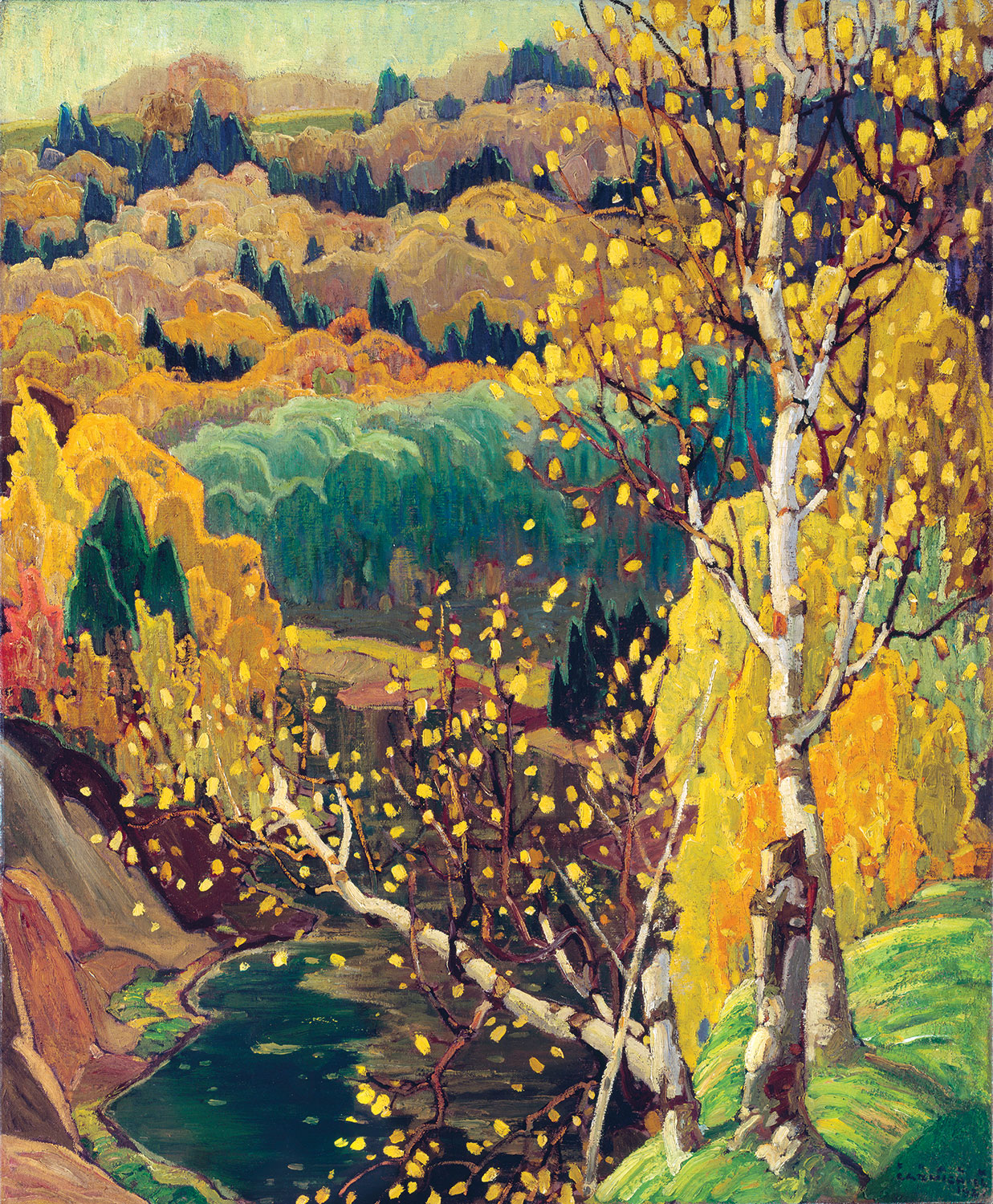
Franklin Carmichael (1890 – 1945), October Gold, 1922, oil on canvas, 119.5 x 98 cm, Gift of the Founders, Robert and Signe McMichael, McMichael Canadian Art Collection
Exploration Questions:
- How many different trees do you see in the painting?
- Where do you think the artist was standing when he painting this artwork?
- Are the trees different sizes?
- Are some trees closer to you? How do you know?
Activity description:
Let’s make an artwork about our favourite season using nature itself! Collect items from nature (leaves, twigs, grass and petals) to create your artwork. Think about how your items can transform on your paper; a petal can become a cloud and a branch can become a tree. Use your imagination to depict fall, summer, spring or winter.
Natural elements are often used by artists to create sculptures, carvings and even artmaking tools. On the McMichael grounds, the Shibagau Shard by artist Bill Vazan is a wonderful example of how stone can be used to make an artwork. This artist has also used another natural element, sand, to help him carve the images into the rock. Search for and use natural elements around you to act as your paintbrush when designing your next work of art!

Bill Vazan, Shibagau Shard, 1989, granite, 2.8 x 4 x 2 m, Donated by William Vazan, McMichael Canadian Art Collection
Exploration Questions:
- Can you see different lines and shapes in this sculpture?
- How many textures do you see?
- Do you see a figure carved into the stone?
Activity description:
Venture outside to your yard or go for a walk to a green outdoor space approved by your parent or guardian. Collect natural elements like branches, leaves, pinecones and grass. Use only these items to create your painting! Can you paint a figure using a using a stone, or use pine needles as a paintbrush?
Communities, neighbourhoods and especially our homes hold a significance in our lives. Artist John Hartman loves to capture the cities, towns and communities that are important to his fellow Canadians.
As part of his recent project, Hartman painted portraits of leading Canadian authors and behind them, a place that they love. Have a look at the painting below which places Canadian author David MacFarlane in his hometown of Hamilton. Observe how the artist has added objects that are important to MacFarlane, such as his swimming pool. Think about how you would paint your special place. Is it your room, the backyard or your favourite park? Complete your painting with a self-portrait to mark the landscape as your own.

John Hartman (b. 1950), David Macfarlane above Hamilton, 2014, oil on linen, 60 x 66 inches, Courtesy of the Nicholas Metivier Gallery, Toronto, Photo credit: Joseph Hartman
Exploration Questions:
- What do you see directly behind the figure in this painting?
- How is the figure positioned within the painting?
- What do you see in the background?
Activity description:
Paint a landscape of your favourite place. Find or print a photo of yourself, cut it out and glue it onto your landscape. Where have you placed yourself in the landscape? Does this painting tell a story about you?
The next time you visit the McMichael, you’ll be able to find many artworks both inside and out. One of the outdoor works of art is particularly interesting. Artist Mary Anne Barkhouse created a thought-provoking sculpture called Lichen, featuring three wolves that attract visitors’ attention year-round. Through their poses and facial expressions, these wolves attempt to share their stories with the public. In this activity, you will use your imagination to create a three-dimensional animal.
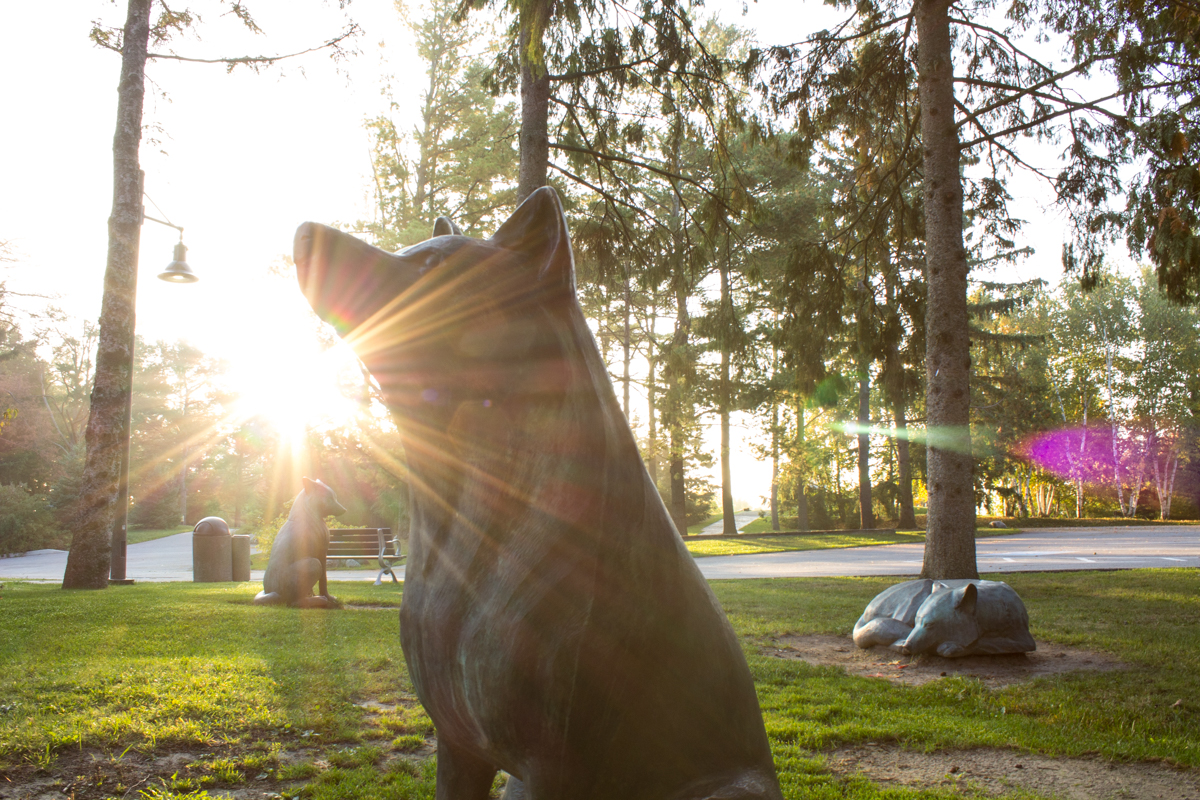
Lichen, by Mary Anne Barkhouse (born 1961) and Michael Belmore (born 1971)
Exploration Questions:
- What do you think the wolves are trying to say?
- What do you like about outdoor sculptures?
- What details do you see in the wolf sculptures?
Activity description:
Collect images of your favourite animal and look at the shapes used to create the eyes, nose, ears and mouth. Use modelling clay to create your own three-dimensional animal. Add some lines and texture to give your new friend some character! Is your animal feeling happy, sad or maybe even mischievous?
Artist Norval Morrisseau drew inspiration from the legends of his Anishinaabe heritage and often painted figures and animals in his colourful artworks. Look closely at his painting, Shaman and Disciples, to see if you can find smaller animals painted inside the larger figures. Can you find the birds? Look even closer to find the snake. Think about your favourite animal and what colours you would use to paint it in Morrisseau’s style.

Norval Morrisseau (1932–2007), Shaman and Disciples, 1979, acrylic on canvas, 180.5 x 211.5 cm, Purchase 1979, McMichael Canadian Art Collection 1979.34.7
Exploration Questions:
- How many shapes has the artist used to create the animals?
- How many colours do you see in this artwork?
- How many animals can you find?
Activity description:
Explore your yard or a green space that your parent or guardian feels is safe to collect natural materials to paint on. Rocks, pebbles, sticks or pine cones are great examples of items you might wish to work with. Think about how you can transform your natural item into a representation of your favourite animal using painted shapes. Use bright colours to help your animal really stand out!
Animals have often served as the inspiration for Canadian artists. The Inuit artist and sculptor Pauta Saila was a master at carving stone into the shapes of the animals that surrounded him. In his work, Polar Bear, we see the lumbering shape of a massive bear on the hunt. We can feel its movement and energy from all sides as we walk around the form. Now it’s your turn to bring an animal to life.

Pauta Saila (1916–2009), Polar Bear, 1967, limestone, 153 x 170 x 168 cm, Gift of City of Toronto, McMichael Canadian Art Collection, 1981.139
Exploration Questions:
- How many animals can you find in this sculpture?
- What do you think is happening in this sculpture?
- How are sculptures and carvings different from paintings and drawings?
- Why do you think the artist chose to work with stone?
Activity description:
For this activity, we will be creating a paper animal sculpture inspired by the carvings of Inuit artist Pauta Saila. Think about a wild animal that lives in your region or in another part of Canada (examples: fish/seal/snakes/bears/raccoons/squirrels), then get ready to take on a special sculpting adventure!
For centuries, artists have used the beauty of flowers as inspiration for their art. Many artists choose to paint lowers indoors, using pre-set floral arrangements. The resulting artworks are called still life paintings. Unlike many of his peers, the Canadian artist Tom Thomson preferred to paint outdoors, capturing the beauty of untouched nature. Now, it’s your turn to draw inspiration from Tom Thomson’s example and paint your own wild flowers!

Tom Thomson (1877–1917), Wildflowers, 1915, oil on board, 21.6 x 26.8 cm, Gift of Mr. R.A. Laidlaw, McMichael Canadian Art Collection, 1970.12.2
Exploration Questions:
- How many kinds of flowers do you see?
- What kinds of different lines or shapes can you find? Try tracing them with your fingers.
- What colours are the flowers and plants in Thomson’s painting?
- If you zoomed-in on the painting, would you still be able to tell the objects are flowers? Why or why not?
Activity description:
The natural beauty of flowers has inspired many artists, including Canadian art pioneer Tom Thomson. In this activity, we are going to celebrate spring by making our very own hand-painted paper flower bouquet. While it can be nice to be inspired by nature, there are no rules here about the colours and designs you choose to make your flowers, so be creative and experiment!

Norval Morrisseau (1932–2007), Thunderbird with Inner Spirit, c. 1978, acrylic on canvas, 208.3 x 127 cm, Purchase 1979, McMichael Canadian Art Collection, 1979.6
Anishinaabe artist Norval Morrisseau (1932–2007) was an innovator in his field of art. He drew inspiration from the legends of his Anishinaabe heritage—which had previously only been shared through the oral tradition of storytelling—and brought the characters and creatures to life on a painted canvas. In his work Thunderbird with Inner Spirit (c. 1978), Morrisseau is telling us about his culture and about himself through the spirit of the animal.
Like Morrisseau, many artists have used non-traditional materials to make their art. Although we may not think of acrylic paint as a non-traditional material, at the time Thunderbird with Inner Spirit was painted, the acrylic paint was a fairly new innovation and not commonly used by professional artists.
Today, we’re going to challenge you to paint a self-portrait of your spirit animal.
Exploration Questions:
- Trace the outline of the thunderbird with your finger and try to identify all the different parts.
- Can you find the inner spirit? Why do you think the artist hid his portrait inside of the animal spirit?
- There are many colours in this painting. Can you list all of them? Try to keep count on your fingers.
- What information can you figure out about the artist by looking at his self-portrait? For example: “I think he was ________ because______.”
Activity description:
For this activity we will be creating a painting using home-made stamps. Norval Morrisseau identified with the thunderbird in his painting. We could even consider his painting of the bird as a self-portrait. Is there an animal you identify with or feel connected to? How would you make a painting of yourself as this animal?
Gallery Explorers
8 – 12 years old
Gallery Explorers introduces kids to the history of Canadian art and encourages personal artmaking at home. With new projects added each week, learn the story of well-known Canadian masterpieces as well as some lesser-known surprises by the Group of Seven, Tom Thomson, Norval Morrisseau and other Canadian artists from the past to the present. Each discussion is accompanied by an art activity related to the artist or artwork.

“Nulla dies sine linea” – No day without a line
For the Group of Seven artist Arthur Lismer, sketching was a way of life. He was a skilled draughtsman, an individual who creates detailed drawings.
Lismer often drew in his sketchbook, on table napkins, on pieces of newspaper, and anything else he could find. He developed this habit at a young age, when he was apprenticing with Sheffield’s Independent local newspaper as a black & white news illustrator.
The McMichael’s permanent collection includes a number of Lismer’s “cartoons” that offer a delightful record of his family life, meetings with friends, travels and scenes that he encountered on the streets of Toronto.
Follow Arthur Lismer’s lead and create your own sketchbook to make daily drawing a part of your life!
Gallery Stop
Tom Thomson had two passions in life: fishing and painting. He combined his two hobbies by bringing his painting boards on his outdoor adventures. Thomson was always after a big fish and the best views to paint.
The McMichael is home to one of the most extensive collections of Tom Thomson sketches in the world. Thomson produced these tiny sketches during his wilderness excursions, and used them to create larger paintings back at his studio in Toronto.
Today, we’re going to explore the concept of painting en plein air and become Tom Thomson for a day!
Gallery Stop
Artist Norval Morrisseau took inspiration from the spiritual heritage of his Anishinaabe community and saw all beings as irrevocably connected.
In his mind, humans, plants, animals and inanimate objects are unified by a flow of spiritual energy. In his paintings, this flow is represented by a black line that runs through the composition and interlocks shapes and colours into a single vision of the world.
Can you try to see the world around you through Morrisseau’s eyes?
Gallery Stop
World through Geometry Lenses
Group of Seven artist Lawren Harris had an extensive career that spanned more than 60 years. Throughout his career, Harris changed his style several times, however, he is perhaps best known for his paintings created in the 1920s and 30s, which were inspired by his travels throughout the Canadian Rockies.
The large canvases that Harris produced during this time are characterized by simplified geometrical shapes and a reduced colour palette.
Today, we challenge you to try to see the world through Harris’ geometric lenses.
Gallery Stop
Ivan Eyre is known primarily as a painter, and his works explore the tense relationship between objects and their backgrounds. His compositions often surprise audiences with striking visual space contradictions, unrealistic proportions and strange shadow distributions. We can see how the artist tries to challenge us to rethink what we see and understand.
What do you think the artist was trying to make us rethink with these sculptures?
Gallery Stop
Artist Carl Ray was born in Sandy Lake Cree Nation and was raised by his grandparents. Ray’s grandfather, a powerful medicine man, shared a number of traditional stories with him that inspired Ray’s imagination and powerfully influenced his paintings.
Ray’s grandfather stressed a community-held view that the worlds of animals and humans were not only strongly interconnected, but also dependent on each other to survive.
Today, respect and responsibility towards the natural world continues to be important part of many Indigenous teachings.
What responsibility do you have towards nature and animals in your own life?
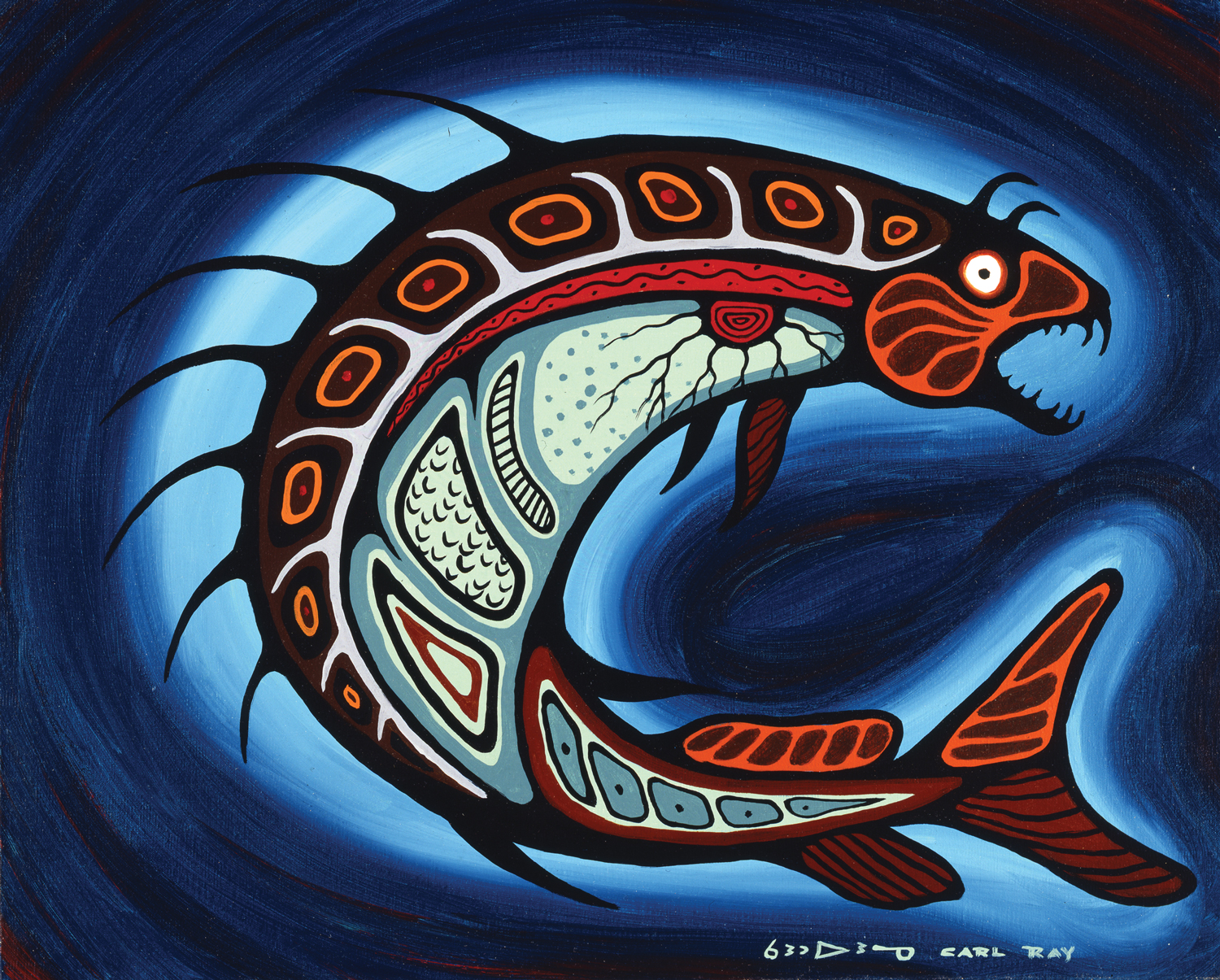
Carl Ray (1943–1978), Spirit Fish, c. 1975, acrylic on canvas, 61.4 x 76.7 cm, Purchase 1975, McMichael Canadian Art Collection
“The sturgeon is part of the water dwelling doodems. These are the ones with wisdom, knowledge keepers and teachers, models of learning and teachings. They point out the land , the first of teachers, we have but to watch and listen.”
-Don Chretien, Ojibwe artist and teacher
Gallery Stop
Summer Memories
Inuit artist Pitseolak Ashoona spent her childhood living on the land. Her family followed the seasons across West Baffin Island in order to remain close to the available hunting grounds, an important form of sustenance for them. Ashoona recalled that summers were the most enjoyable season. The hunting was bountiful, Arctic flora began to bloom and everyone seemed to be busy preparing for the upcoming winter.
Many of Pitseolak’s drawings featured in the McMichael Iningat Ilagiit online exhibition (http://iningatilagiit.ca/) refer to this joyful time. Think about your own summertime experiences and share them online in our Young at Art exhibition.
Gallery Stop
Artist John Hartman is known for painting views of the land and sharing the stories of the people inhabiting it. Hartman’s studio, which is close to Georgian Bay, holds many stories that he has shared with us over the years. Recently, he challenged himself to share the stories of leading Canadian writers and the places that hold special meaning for them.
Often working from photographs, Hartman likes using a birds-eye-view of the land to create a panoramic view. The artist then attaches individual watercolours into an accordion sketchbook, which he later uses as a reference for his larger canvases.
Create an accordion view of your favourite landscape and place the people who are important to you within it.
Gallery Stop
Franklin Carmichael & Modelling Clay Landscapes
The youngest member of the original Group of Seven, Franklin Carmichael often used his breaks from teaching at the Ontario College of Art in Toronto to visit his cottage on Cranberry Lake in Killarney. He loved painting the surrounding La Cloche Mountains, also known as the Bell Rocks. According to Anishinaabe legends, the mountains were warning bells, or tocsins, which could be heard from a considerable distance when struck. This was the reason why the early French travellers named the mountains after la cloche, a French word for “bell”.

Franklin Carmichael (1890–1945), October Gold, 1922, oil on canvas, 119.5 x 98 cm, Gift of the Founders, Robert and Signe McMichael, McMichael Canadian Art Collection
While Carmichael certainly knew this legend, he was attracted to the mountains mostly for their visual beauty. La Cloche is composed of white mineral quartzite, a type of sparkling rock that wonderfully contrasts with the colourful vegetation and forest foliage. Carmichael’s favourite spot was a hill overlooking Killarney’s Grace Lake, where he could see an expansive panorama of lakes and mountains. Today, you’re going to create a modelling clay landscape inspired by Carmichael’s paintings.
Brenda Draney: Memories and Mementos
Brenda Draney is a contemporary painter who grew up living between Edmonton and Slave Lake in Northern Alberta and is Cree from Sawridge First Nation.. An accomplished painter, Draney loves recreating images and snippets of her memories on large white canvases. This process allows her to return to such moments of her life, relive the emotions that accompanied them and to rediscover their meaning in her life retrospectively.
Everyone loves to relive memories. While many of us enjoy revisiting our happiest moments, sometimes it is necessary to revisit painful memories to bring ourselves peace and closure.
Are you ready for a trip down memory lane?
Arthur Lismer: Looking at Myself
During the 1920s, Group of Seven artist Arthur Lismer’s studio was located just a floor above his apartment on Bradford Park Avenue in Toronto. This unusual living arrangement allowed him to work close to his family, including his wife Esther and young daughter Marjorie, while still being able to paint anytime he wished. Lismer was free from the need to dress formally—he only needed comfortable clothes and his slippers.
In this self-portrait, Lismer decided to portray himself in this very personal space while taking a break from painting. Standing in the center of the room, in front of an unfinished canvas, Lismer smokes a pipe while making a quick pencil sketch. We can see by the state of the floor that it was probably not his first of the day. If you look carefully, you can spot a red apple sitting ready for a quick snack.

Arthur Lismer (1885–1969), Self Portrait, 1924, oil on board, 91 x 76.3 cm, Gift of Mr. A.J. Latner, McMichael Canadian Art Collection, 1971.10
What other details can you surmise about Lismer’s life just by looking at the painting? Think about how you would like others to see you if you could paint your own portrait. Today, we’re going to try our hands at the self-portrait.
Gallery Stop
Living with Art Accessible Programming
Age 7+
The McMichael Canadian Art Collection has always been a leader in accessible programming. To support families during our closure, the McMichael is pleased to offer a series of activities that can be enjoyed by families of children living with exceptionalities. Each activity includes step–by–step instructions that take into account various levels of ability, differing sensitivities and materials available at home.
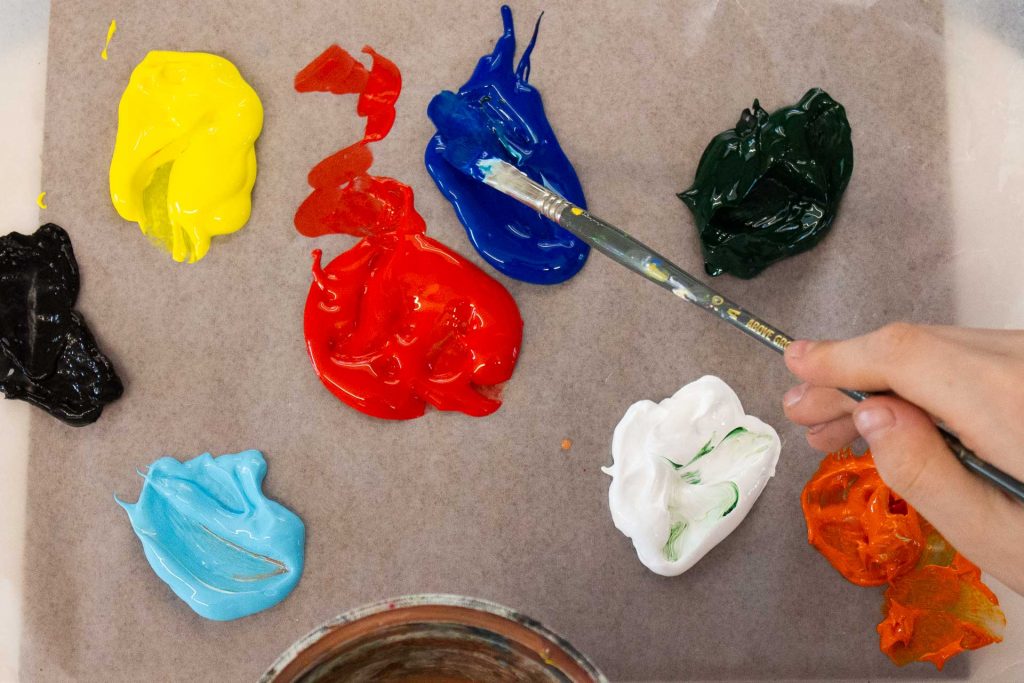
Create a fuzzy flower to decorate your personal space with, or as a gift to someone special. These flowers will be sure to brighten anyone’s day!
Allow your imagination to run wild as you create a beautiful artwork scratched into a colourful underdrawing. The possibilities are endless!
Create a multi-media painting inspired by the textures and patterns of leaves. We’ll challenge you to create a memorable representation of leaves before they disappeared for the winter!
Young at Art Picture Gallery
Love what you made? Post your work on social media and use the hashtag #McMichaelFromHome for a chance to have your work featured here!
My Favourite Season is summer!! @mcacgallery #McMichaelFromHome pic.twitter.com/yPJrbA69yF
— Kathryn Martin (@kmart125) April 12, 2020
McMichael Gallery’s Art Venture Online providing excellent resources for parents to explore nature (from the backyard or balcony) and their child’s creative sensibilities! Definitely check out their step by step lessons! #McMichaelFromHome pic.twitter.com/JiPHd6A5ea
— Kathryn Martin (@kmart125) March 25, 2020
Markland Woods has many beautiful old trees but this was her favourite! She loved the yellow moss growing on the trunk! #McMichaelFromHome @mcacgallery pic.twitter.com/Vy3Z7vYCXv
— Kathryn Martin (@kmart125) March 28, 2020
More great content for you to enjoy from home:
Insight from our Executive Director and Chief Curator—you asked, they answered!
Watch curatorial talks and virtual studio tours with artist across the country.
Perfect your skills with online classes taught live through Zoom by Canadian artists.
Header image credit, clockwise from top left: Edwin Holgate, The Head, 1938, Gift of Edwin and Frances Holgate, 1976; F.H. Varley, Early Morning, Sphinx Mountain, c. 1928, Purchase 1972; A.Y. Jackson, Lake Superior Country (detail), 1924, Gift of Mr. S. Walter Stewart; Frank Johnston, Algoma (detail), 1918, Gift of Mr. and Mrs. John A. Jackson; Arthur Lismer, From My Window, Montreal, 1940–1949, Purchase 1986; Franklin Carmichael, October Gold, 1922, Gift of the Founders, Robert and Signe McMichael; Edwin Holgate, Portrait of Frances, c. 1935, Purchase 1982; J.E.H. MacDonald, Woodland Brook, Algoma (detail), 1918, Gift of the Founders, Robert and Signe McMichael; A.Y. Jackson, Indian Home, Port Essington, B.C., 1926, Gift of Mr. S. Walter Stewart; J.E.H. MacDonald, Moose Lake, Algoma (detail), 1920, Gift of Mr. R.A. Laidlaw; J.E.H. MacDonald, Beaver Dam and Birches (detail), c. 1919, Gift of the Founders, Robert and Signe McMichael; A.J. Casson, October, North Shore (detail), 1929, Purchase 1985. All works McMichael Canadian Art Collection.



